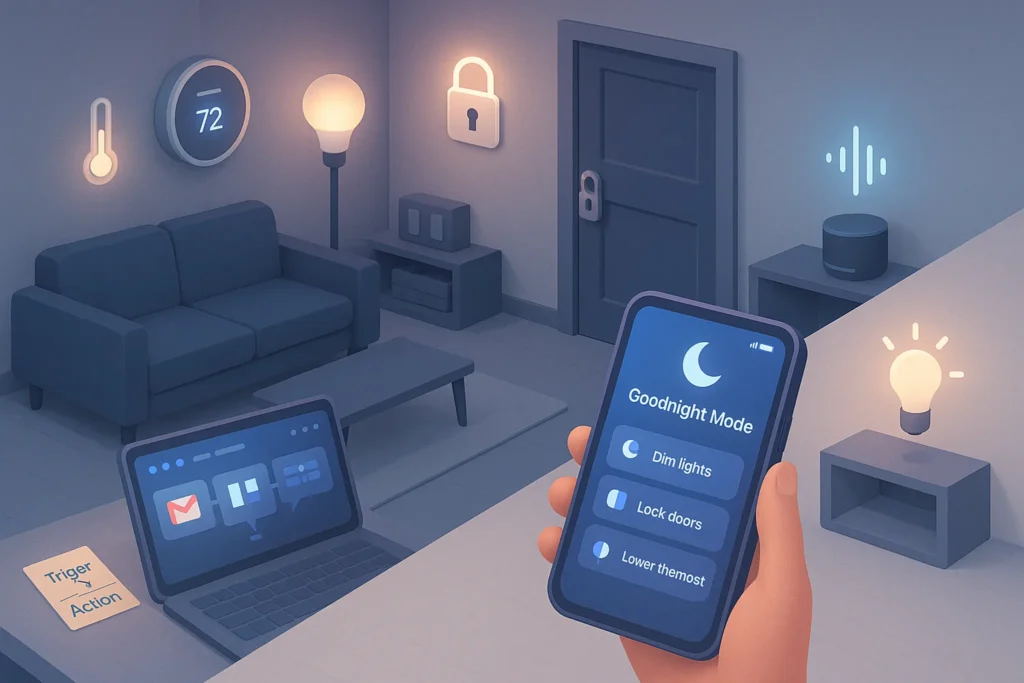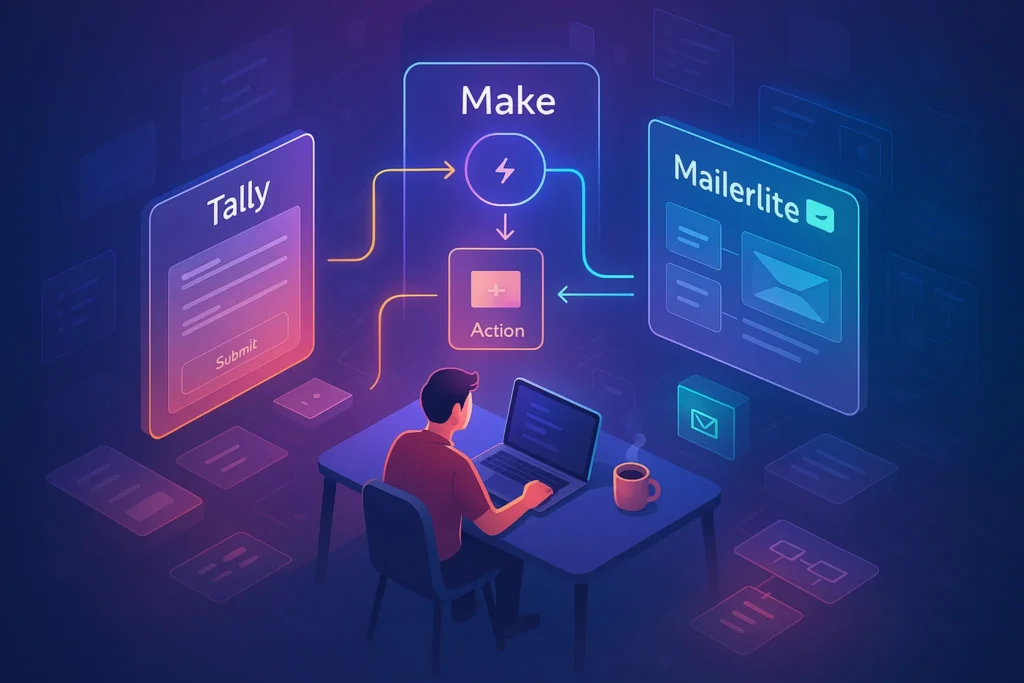-This post may contain affiliate links. If you click on one and make a purchase, I may earn a small commission at no extra cost to you.-
🏠 Introduction: Why Smart Homes Aren’t Just for Tech Geeks Anymore
Once upon a time, home automation was reserved for the ultra-wealthy or the super-nerdy. But today? A smart home is just a smart decision.
From controlling your lights with a voice command to securing your doors with a tap on your phone, Internet of Things (IoT) devices are no longer novelty—they’re essential. Whether you’re trying to save energy, protect your family, or just reduce daily friction, the right home automation setup can make your life significantly easier.
This post explores the best home automation tools that actually simplify your life, and how to pick the right ones based on your needs—not just fancy specs. Whether you’re a solo freelancer or a parent juggling bedtime and Zoom calls, there’s something here for you.
👥 Use-Case Layering: Different Lives, Different Needs
Let’s break it down with real-world personas to show how home automation can deliver personalized value.
👨👩👧 The Busy Parent with a Young Child
Need: Safety, comfort, and control—without running around the house.
-
Smart Locks mean you don’t have to juggle keys with a baby in your arms. Unlock from your phone or with a fingerprint.
-
Smart Lights on bedtime schedules gently dim the room to help wind down kids.
-
Motion Sensors can turn on nightlights for nighttime bathroom trips without waking the whole house.
-
Use a hub like SmartThings to coordinate routines like “Goodnight Mode”: turns off all lights, locks doors, and arms security.
🎁 Bonus: These parents also benefit from routines suggested in the Ultimate Smart Home Setup Guide.
🌙 The Night Owl Freelancer
Need: Quiet focus, energy efficiency, and passive security.
-
Use IFTTT to automatically mute notifications and dim lights at 11 PM.
-
Pair Home Assistant with a motion sensor and ambient noise detector to know if someone’s near the door while you’re deep in work.
-
Smart plugs with scheduling help control background devices like humidifiers or light therapy lamps.
💡 Nerd Tip: We’ve covered how to Secure Your Smart Devices to avoid digital risks while working late.
🌱 The Energy-Conscious User
Need: Reduce electricity usage without micromanaging every switch.
-
Aqara temperature sensors + smart thermostats help regulate heating/cooling based on time of day and presence.
-
Shelly relays let you retrofit old switches with smart logic, even on a tight budget.
-
Get monthly reports from Home Assistant on power consumption and cost-saving tips.
-
Use Alexa Routines like “Leave Home” to power down everything except security.
⚡ Energy nerd? Check out our picks for Smart Home Gadgets Under $100 that save money over time.
🧠 1. SmartThings Hub – The Easy Gateway for Beginners
Samsung’s SmartThings Hub is often the go-to choice for beginners. Why? Because it just works—with hundreds of compatible devices from lights to locks to sensors.
It acts as the brain of your smart home, allowing different brands and protocols (Zigbee, Z-Wave, Wi-Fi) to communicate seamlessly. You can use it to build automation routines like:
-
“When motion is detected after 10 PM → turn on hallway light + send phone alert.”
-
“When the front door is unlocked → disarm security system + turn on entry lights.”
📌 Best For: New users who want reliability and an easy mobile app.
🎯 Example: A parent can set up a “Sleep Mode” routine that dims the lights and locks the doors with one tap.
🧠 2. Home Assistant – Powerful, Private, and Fully Customizable
For power users who want ultimate control, Home Assistant is unbeatable. It’s an open-source platform you can run on a Raspberry Pi or a small server—no cloud required.
You get total flexibility to build complex routines and even create your own dashboards. But with great power comes a learning curve.
-
Supports advanced logic, like:
“If the sun has set AND no one is home → turn on porch light + arm security.” -
Privacy-focused—no data sent to big tech clouds unless you choose.
📌 Best For: Tech-savvy users, freelancers who work at night, or privacy-focused households.
🎯 Example: A night owl can build a silent “Work Mode” that disables all noisy appliances during deep work hours.
🆚 Mini Comparison:
| Feature | SmartThings | Home Assistant |
|---|---|---|
| Setup | Easy | Technical |
| Cloud-Free | ❌ No | ✅ Yes |
| Custom Logic | Moderate | Advanced |
| Best For | Beginners | Power Users |
🧠 3. Aqara, Shelly & Sonoff – Modular & Affordable Automation
If you’re not ready to replace every device in your home but still want smart control, modular automation tools like Aqara, Shelly, and Sonoff offer the perfect middle ground.
If you want to upgrade specific switches, sensors, or plugs without replacing entire systems, these brands are your best friends:
-
Aqara: Great for sensors (motion, temp, door/window), often Zigbee-based
Aqara excels at smart sensors (motion, door/window, temperature/humidity, vibration) with Zigbee protocol support. It’s ideal for building custom triggers and energy-efficient automations. These sensors work flawlessly with platforms like Home Assistant, Alexa, and Apple HomeKit.
-
Shelly: Wi-Fi relays that turn any dumb switch into a smart one
Shelly specializes in Wi-Fi-based relays and modules that can be installed behind existing wall switches or outlets. This means you can upgrade your current home setup without changing the visible hardware. Shelly also offers smart plugs, energy meters, and wall switches—all with fine control and local API options.
-
Sonoff: Budget-friendly smart plugs and switches with reliable cloud control
Sonoff is known for its super budget-friendly smart switches and plugs, especially useful for people just experimenting with home automation. Many Sonoff devices support Tasmota or ESPHome, enabling custom firmware for advanced users.
📌 Best For: Tinkerers, budget-conscious users, or renters
Renters, tinkerers, budget-conscious users, and anyone who wants granular control without investing in a full ecosystem.
🎯 Example: Use Shelly to turn your old light switch into a smart one without replacing your wall panel.
You can install a Shelly 1PM inside your wall switch and pair it with a motion sensor from Aqara. When the sensor detects movement after sunset, it automatically turns on the hallway light—and turns it off after 2 minutes.
🧠 4. IFTTT – Easy Automation for Everyday Events
IFTTT (If This Then That) is one of the most accessible automation platforms for non-techies. It lets you connect thousands of services using simple logic: “If X happens, then do Y.”
Its power lies in connecting services that don’t natively talk to each other—think Google Calendar, Spotify, Weather, Instagram, Alexa, and more.
✅ Popular use-cases:
-
When you leave work → Set home thermostat to 22°C
-
If your Ring doorbell detects motion → Blink Philips Hue lights
-
When tomorrow’s forecast shows rain → Add “umbrella” to your to-do list
You don’t need coding skills or expensive hardware—just an internet connection and creativity.
⚠️ Limitations:
-
Mostly cloud-based, so not ideal for time-sensitive or security-critical routines.
-
Has become more limited under the free plan (3 custom applets max).
IFTTT (If This Then That) helps you build simple chains of logic like:
-
“If it rains tomorrow → remind me to take an umbrella at 7 AM.”
-
“If I enter home → turn on my favorite Spotify playlist.”
It integrates with smart home platforms like Ring, Alexa, SmartThings, Google Home, Philips Hue, and more.
📌 Best For: Users who want automation without deep technical setup
New users, casual automators, or anyone looking to tie together basic digital workflows quickly and easily.
🎯 Example: Parents can use IFTTT to send a phone notification every time the front door opens between 2–5 PM.
🧠 5. Voice Assistants: Alexa, Google Home, & HomeKit
Voice assistants aren’t just fancy speakers—they’re powerful control hubs for your smart home routines.
While not automation tools per se, voice assistants play a crucial role in controlling your routines. Here’s how they fit in:
-
Amazon Alexa: Offers “Routines” that can string together multiple actions
Best-in-class support for third-party devices
Lets you create “Routines” (e.g. say “I’m home” to turn on lights, disable alarms, play music)
Integrates with SmartThings, Ring, Philips Hue, and more
-
Google Home: Great for commands tied to your Google Calendar, reminders
Great for Android users or those deep in Google’s ecosystem
Seamlessly pulls data from Gmail, Calendar, Maps to create context-aware routines
Superb voice recognition and natural language processing
-
Apple HomeKit: Privacy-focused and integrated with Apple ecosystem
Best for users who prioritize privacy and use iOS devices
Runs automations locally (via HomePod or Apple TV as a hub)
Integrates natively with Siri and Apple’s secure infrastructure
📌 Voice Tip: Combine Alexa with a SmartThings or Shelly setup to control lights, fans, and door locks with a single voice command.
🎯 Use-Case Example: A freelancer can say “Start Work Mode” and trigger a chain: turn on desk lamp, play focus music, disable phone notifications via Do Not Disturb mode.
🎯 Example: Say “Goodnight” and Alexa turns off all lights, locks doors, and starts white noise for your baby.
🧠 6. IoT Buttons – One Tap, Multiple Actions
Remember Amazon Dash buttons? You can now create your own versions using:
IoT buttons might look like toys—but they’re secretly one of the most efficient smart triggers available.
These programmable physical buttons can be assigned different functions based on how you press them: single-tap, double-tap, long-press.
-
Flic Buttons
-
Shelly Button1
-
Aqara Wireless Mini Switch
🟢 Popular IoT Buttons:
-
Flic 2: Bluetooth button that works with phone or hub. Portable and customizable.
-
Aqara Mini Switch: Works with Zigbee hubs. Lightweight and affordable.
-
Shelly Button1: Wi-Fi-based button with offline fallback and USB-C charging.
✅ Example Uses:
-
Single tap: Turn off all lights in the house
-
Double tap: Start morning routine (lights, coffee, news podcast)
-
Long press: Trigger “panic mode” (turn on siren + all lights + send SMS)
These buttons are especially helpful for:
-
Kids and elderly who don’t want to use apps
-
Visitors who don’t have voice assistant access
-
Quick access in emergencies (e.g. bedside panic mode)
📌 Ideal For: Families, accessibility needs, silent mode lovers, and anyone who wants physical shortcuts
📌 Best For: Elderly users, kids, or quick-access tasks without screens
🎁 Bonus: 10 Home Automation Ideas That Actually Make Life Easier
You’ve seen the tools—now here are some practical automation ideas you can implement today, using the platforms we just covered.
1. “Goodnight Mode” Routine
-
Turns off all lights
-
Locks doors
-
Arms security system
-
Dims bedroom light or plays white noise
🔧 Tool: SmartThings, Alexa Routine, or Home Assistant
2. Sunset-Based Outdoor Lighting
-
Automatically turns on porch and driveway lights at sunset
-
Turns them off at sunrise or after midnight
🔧 Tool: Home Assistant with sun sensor or Google Home Routine
3. Presence Detection Automation
-
When the last person leaves the house → Turn off AC + all lights
-
When someone returns → Turn on hallway light + disarm system
🔧 Tool: Home Assistant with Wi-Fi tracker or SmartThings + geofencing
4. Smart Baby Monitor Mode
-
If noise is detected in nursery after 10 PM → Turn on dim light + send phone alert
-
Optionally, play lullaby on smart speaker
🔧 Tool: Aqara sound sensor + Alexa or Google Home
5. Auto-Lock Doors at Night
-
If front/back door is unlocked after 10 PM → Send alert
-
If still unlocked at 10:30 PM → Auto-lock it
🔧 Tool: Smart lock + IFTTT or Home Assistant logic
6. “Work Mode” for Freelancers
-
Turns on desk lamp + air purifier + do-not-disturb on phone
-
Optionally blocks social media using router rules
🔧 Tool: Shelly plug + IFTTT + VPN/Router control
7. Room-Based Climate Control
-
When temp in bedroom < 20°C → Turn on heater
-
When temp > 25°C → Turn off heater + open smart window
🔧 Tool: Aqara sensors + Home Assistant + smart HVAC plugs
8. Morning Routine with Weather & Traffic
-
At 7 AM: Turn on lights gradually + read weather aloud + tell traffic status to work
-
Optionally starts coffee machine via smart plug
🔧 Tool: Google Home or Alexa + smart plug + IFTTT
9. Panic Button
-
Long-press IoT button → Turn on all lights + send SMS to emergency contact
-
Optional: Trigger indoor siren
🔧 Tool: Flic or Aqara button + Home Assistant + IFTTT webhook
10. Energy Saving When Window is Open
-
If window sensor detects open → Turn off HVAC in that room
-
Resume when window is closed
🔧 Tool: Aqara or Sonoff sensor + Shelly + Home Assistant rule
🧠 Nerd Verdict: My Take on Smart Home Automation
As someone who’s tested both “plug-and-play” hubs and painfully complex DIY setups, I can confidently say this: home automation only works when it serves you—not the other way around.
If you’re just starting out, SmartThings is a no-brainer. It handles 90% of typical use-cases with minimal effort. But if you’re a night owl like me, who wants granular control (think: turn off the hallway light only after the dog returns inside 🐶), Home Assistant is worth the learning curve.
My top combo?
-
Shelly + Aqara sensors + Home Assistant for deep control
-
Alexa for voice commands and quick routines
-
A Flic button by my bed to shut the whole place down with one press
Start small. One routine. One trigger. One moment of friction removed from your day. That’s the smart way to build your smart home.
❓ FAQ: Nerds Ask, We Answer
Q: Is Home Assistant hard to install for non-techies?
A: It’s more technical than most platforms, but YouTube tutorials and the active community make it manageable. Raspberry Pi kits make setup easier for beginners.
Q: Do I need a hub to get started with smart home devices?
A: Not always. Many devices like smart plugs and lights work over Wi-Fi without a hub. But for better automation and long-term scaling, a hub (like SmartThings) or platform (like Home Assistant) helps.
Q: Can I trust IFTTT with my home automation?
A: For simple triggers, yes. But it’s cloud-dependent and has limitations for complex tasks. Consider local platforms (like Home Assistant) for mission-critical automations.
Q: Is Apple HomeKit better than Alexa or Google Home?
A: HomeKit is great if you’re deep in the Apple ecosystem and value privacy. Alexa and Google are more flexible and compatible with third-party devices.
💬 Would You Bite?
What’s your biggest home annoyance you wish could be automated?
Forgetting to lock the door?
Waking up cold at 3 AM?
Leaving lights on all day?
Tell us below—and we might feature your use-case in our next automation idea roundup. 👀 👇



